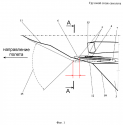As the patent shows, yes:
View attachment 58728
Well, you can doubt all you want, but it really does precisely that!
Note how the pylon appears to have shielded the wing outboard of itself, however - why would the exhaust not leave residue on either side of the pylon axis? As the bay door faces outward on the canoe, that the smoke stains from an internal missile launch are primarily outboard is not a surprise. Particularly since (based on the patent) the firing position has the missile nozzle pointed inwards, so there is probably a deflector on the launch rail to direct the plume outwards, like on the F-22.
The patent drawing says that's exactly the way it is, and the area on the LERX above the canoes is marked with "No Step" on the actual aircraft, like the main wheel wells on the Flanker.
There are good reasons to believe the compact SRAAM is actually no such thing. There are old photos of the R-77 production line which show missiles temporarily assembled with the rocket motor section missing, presumably for easier handling (only one piece to move around the factory).
View attachment 58729
As your picture shows, the canoes are considerably longer than the R-74 (which is less than 3m), at least as long as the main bays which have an interior length of 4.2m. Within that envelope it should be quite feasible to provide a roughly constant cross section over sufficient length for a missile with a fin span 20% shorter than the AIM-9M.





